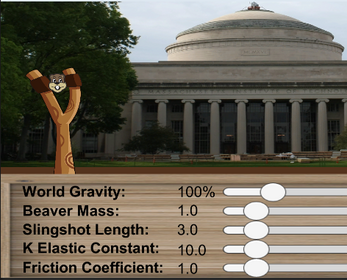Busy Beavers ES.801 Project Fall 2020
Teaching Physics Through Video Games Project Summary
Group Members:
Harry Heiberger, Henry Heiberger, and Sabrina Queipo
Context: Creating an interactive pedagogical tool to display physics concepts to students
Problem Definition:
The laws of classical mechanics describe the motion of celestial objects as well as the motion of everyday life objects. Yet, despite this prevalence, the average student’s understanding of these concepts is reaped with misconceptions. Thus, our goal is to address some of these misconceptions through a virtual game interface.
Model:
Using computer science principles and our knowledge from 8.01, we programmed in Unity an interactive 2D game resembling “angry birds” that displays fundamental physics concepts and measurements. These include projectile motion, elastic forces, gravity, energy, among others. This model will be used as a proof of concept of the effectiveness of teaching physics through virtual simulations.
Key Features:
User Friendly Interface
Coming into the project, we wanted to make sure that it was something that could be used by physics students of any age. Thus, starting from the main splash screen, the game was designed in a simple and instantly recognizable fashion that could be run on any machine, allowing the learning benefits of the game to be accessible to more students.
Accurate Physics Representation
The complex interactions between friction, gravity, elastic forces, rigid body collisions, and rotation and translation are concepts that can be more difficult to grasp for students just starting out in physics. Thus, we sought to ensure that they were a highlight within our game. The game was designed to model an ideal physics scenario as closely as possible, with the elastic force from the slingshot following Hooke’s law, the path of the Beaver following projectile motion, and the collision between the Beaver and the objects displaying the properties of a rigid body collision. In fact, friction can even be disabled to display point particle interaction.
Powerful Physics Controller
We also entered the project wanting the user to have complete control over the physics of the game. From the scale of world gravity and the beaver’s mass to the slingshots k elastic constant and the friction coefficient between the Beaver and other objects, the physics controller provides a simple way to do just that. By enabling the user to adjust game physics at any point, students are provided limitless ways to test their hypotheses and perform experiments, allowing them to more easily learn.
Trajectory Prediction
Of course, the physics controller provides students with a lot of control over the environment of the game. However, for a student new to physics, it may be harder for them to predict how that will affect the Beaver’s flight path. Thus, employing kinematic equations, when the Beaver is aimed with the slingshot, an accurate path prediction is drawn directly reflecting the values input into the physics controller. Thus, the student receives immediate feedback about whether their change will produce the desired result, enhancing the learning experience.
Realtime Physics Measurements
Finally, through this game, we wanted to more clearly show users the meaning behind several of the terms they’ve learned in class. By providing a dashboard of gauges that reflects the magnitude of these terms in real time, the connection between the motion of the Beaver and more abstract concepts such as kinetic energy and momentum can be directly seen, improving the user’s understanding.
Impact:
In the midst of an era of online classrooms and global pandemics, it is more than ever a challenge for students to overcome learning gaps, and for teachers to boost students' intrinsic motivation and curiosity. Games are novel tools that help tackle this issue. In fact, games are associated with a higher effectiveness in learning than more traditional instructional methods. Therefore, we hope we have created a tool that allows students from different backgrounds and learning abilities to have fun while learning and strengthening their understanding of core physics concepts that can otherwise seem abstract or confusing. By incorporating a strong mix of interactability and physics analysis, we believe we have designed a project that is both fun and educational for all age levels.
The game can be found here and be used as a source of instruction, entertainment, or inspiration for future projects. Even with no solid previous knowledge of Unity, programming and creating this game was feasible, fun, and a learning experience for both us the creators and for prospective users. Thus, we encourage future students to use their skills and creativity to further experiment with and to develop accurate simulations and instructional tools for any subject of their interest, not limited to physics.
| Status | Released |
| Platforms | HTML5 |
| Author | henryrh |
| Genre | Educational |
| Made with | Unity |
| Code license | GNU General Public License v3.0 (GPL) |

Leave a comment
Log in with itch.io to leave a comment.